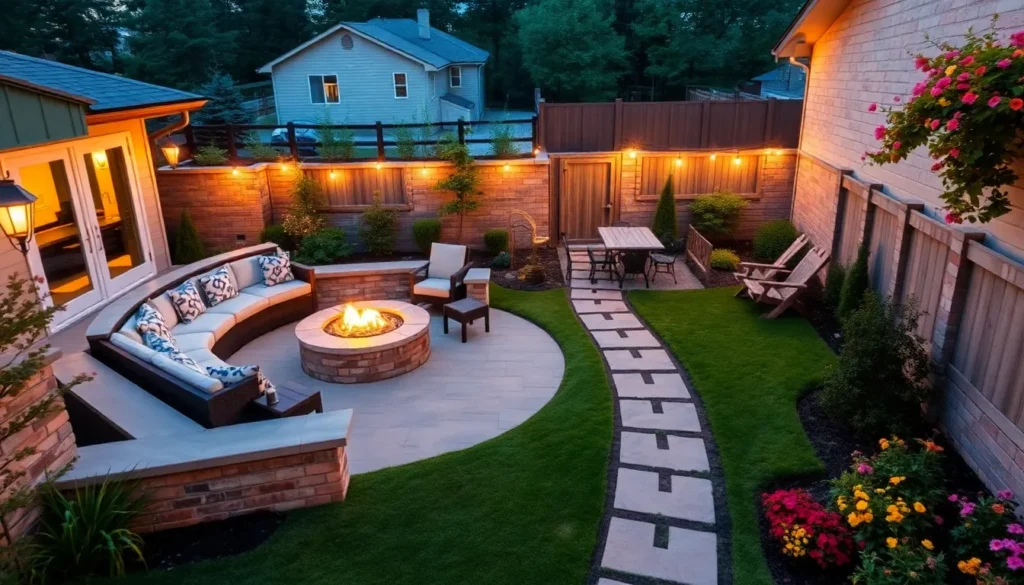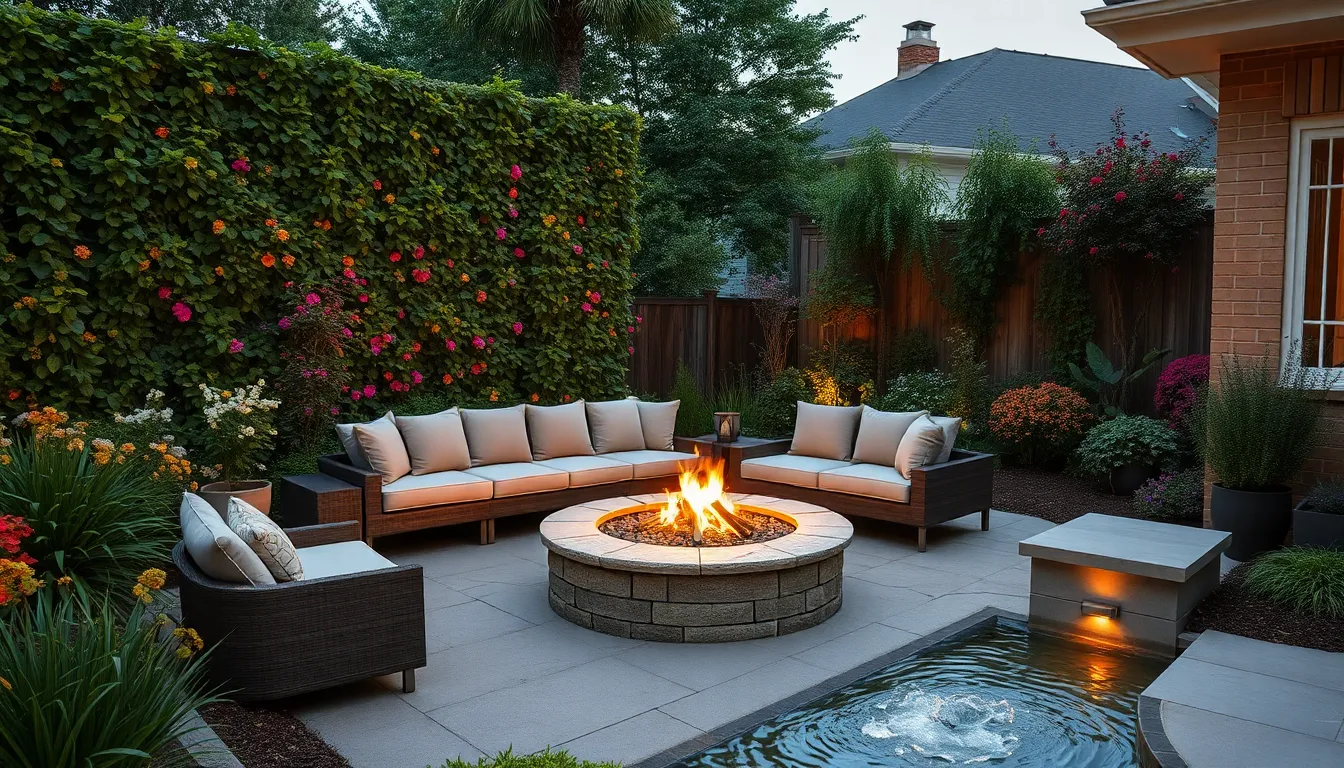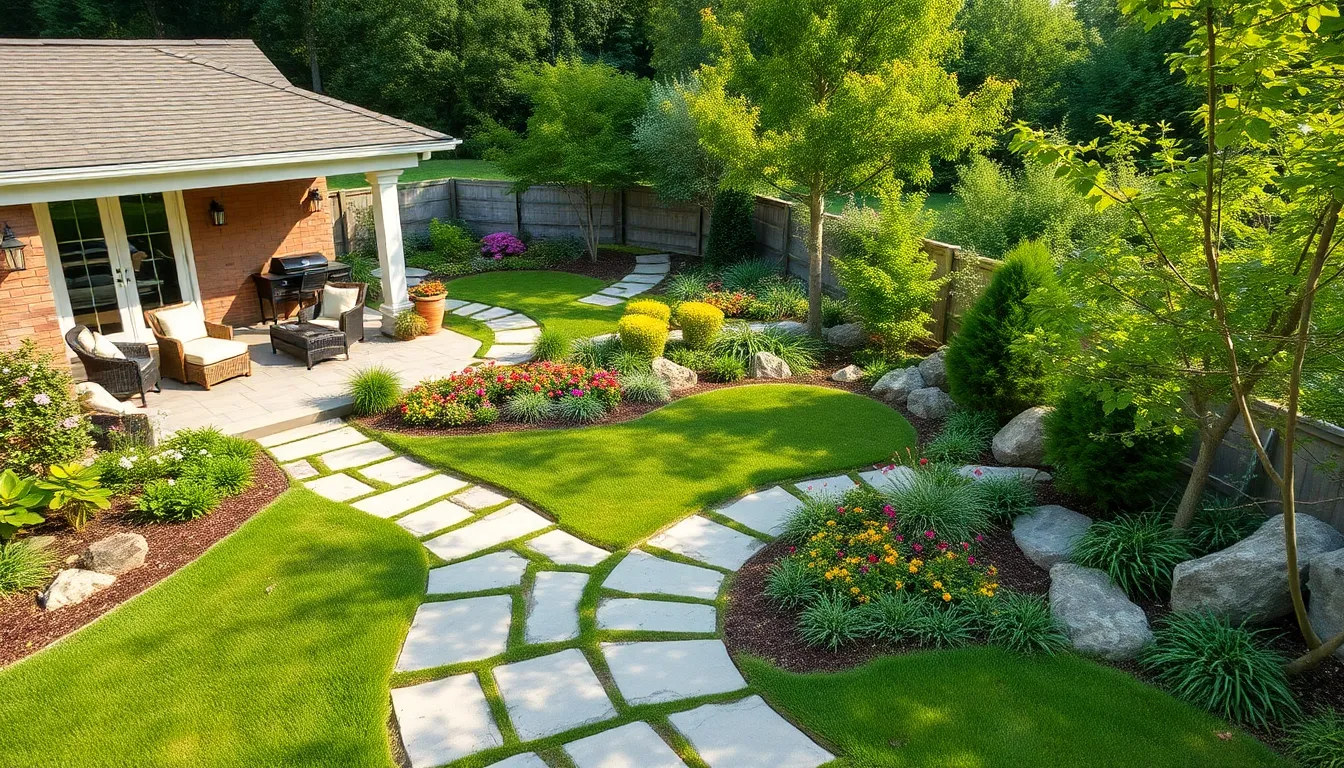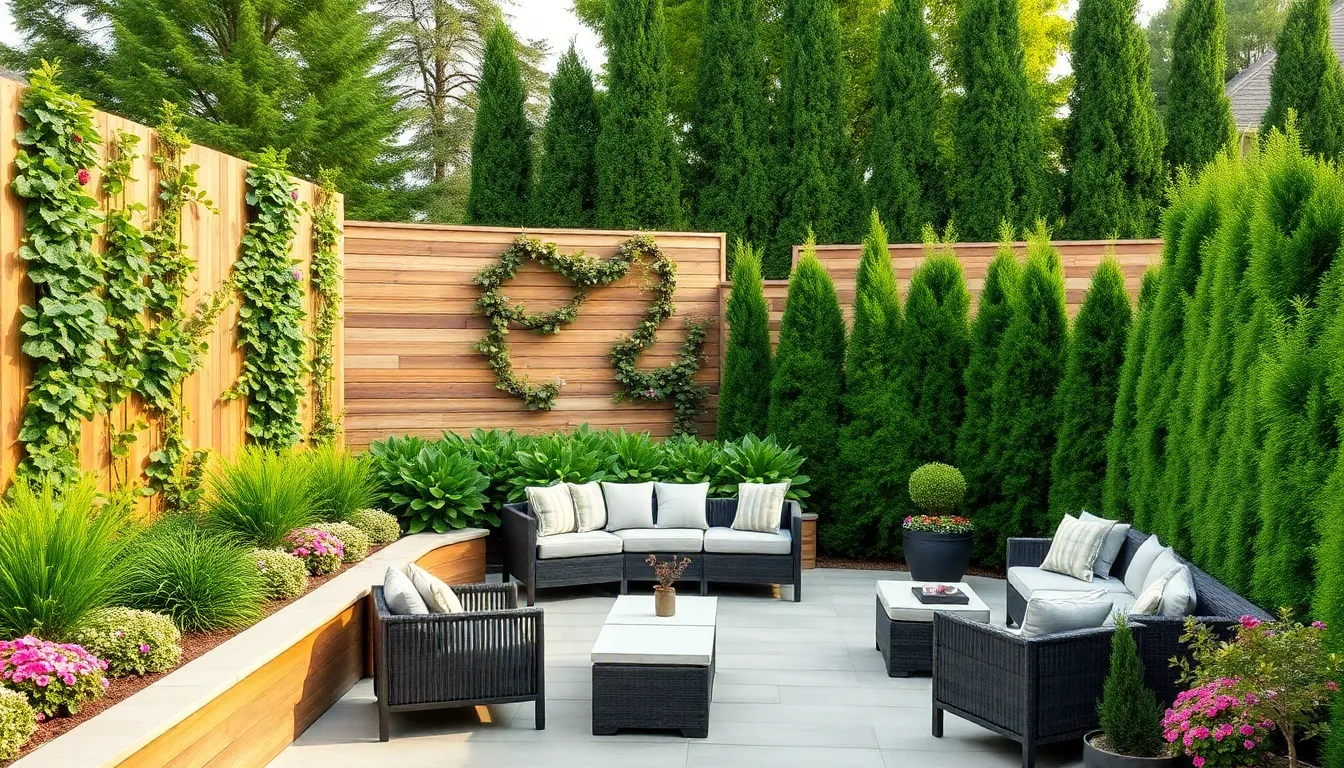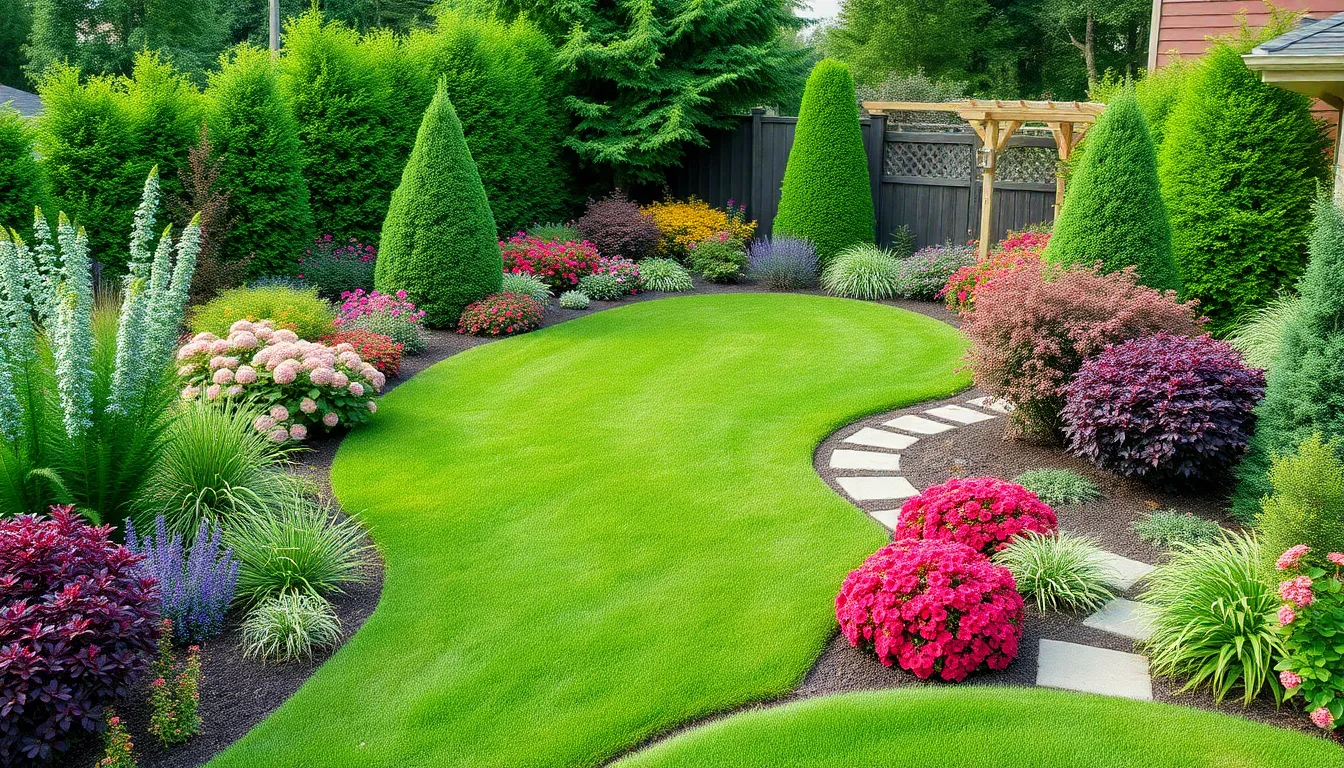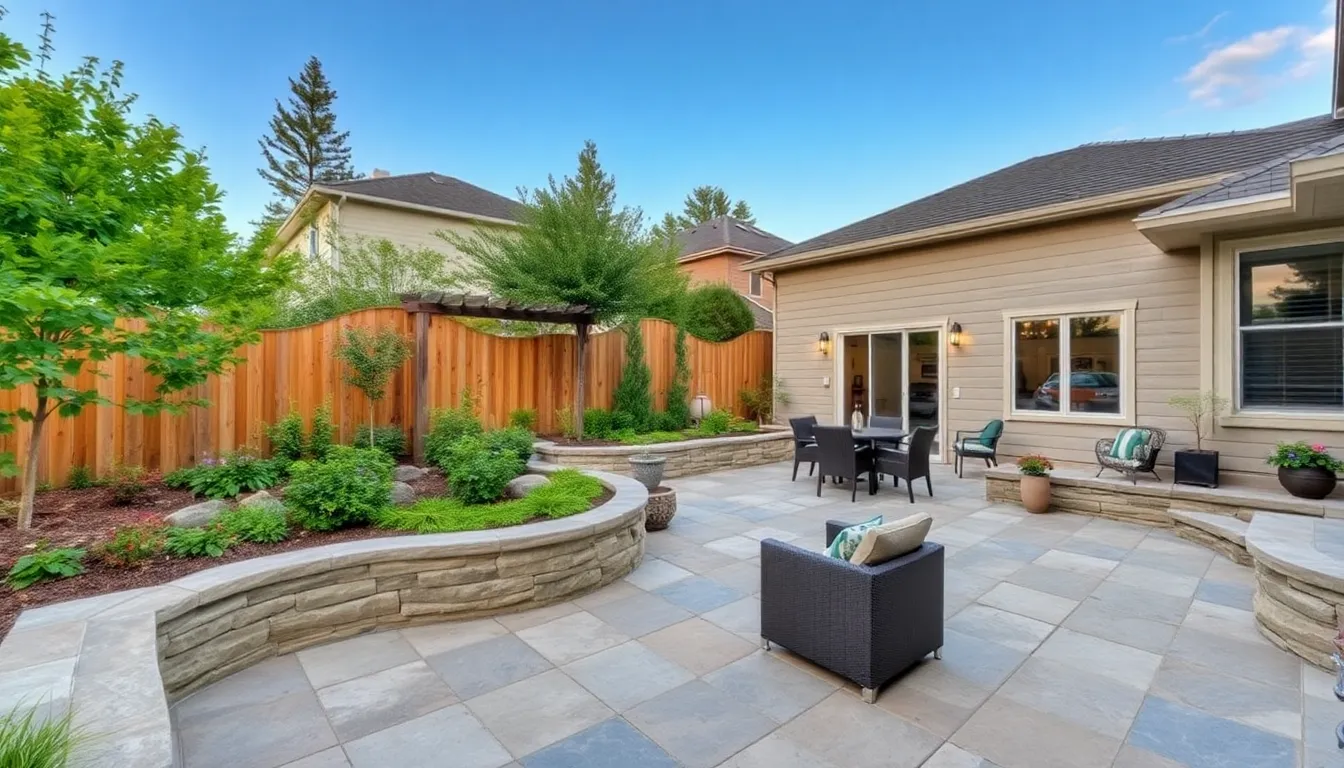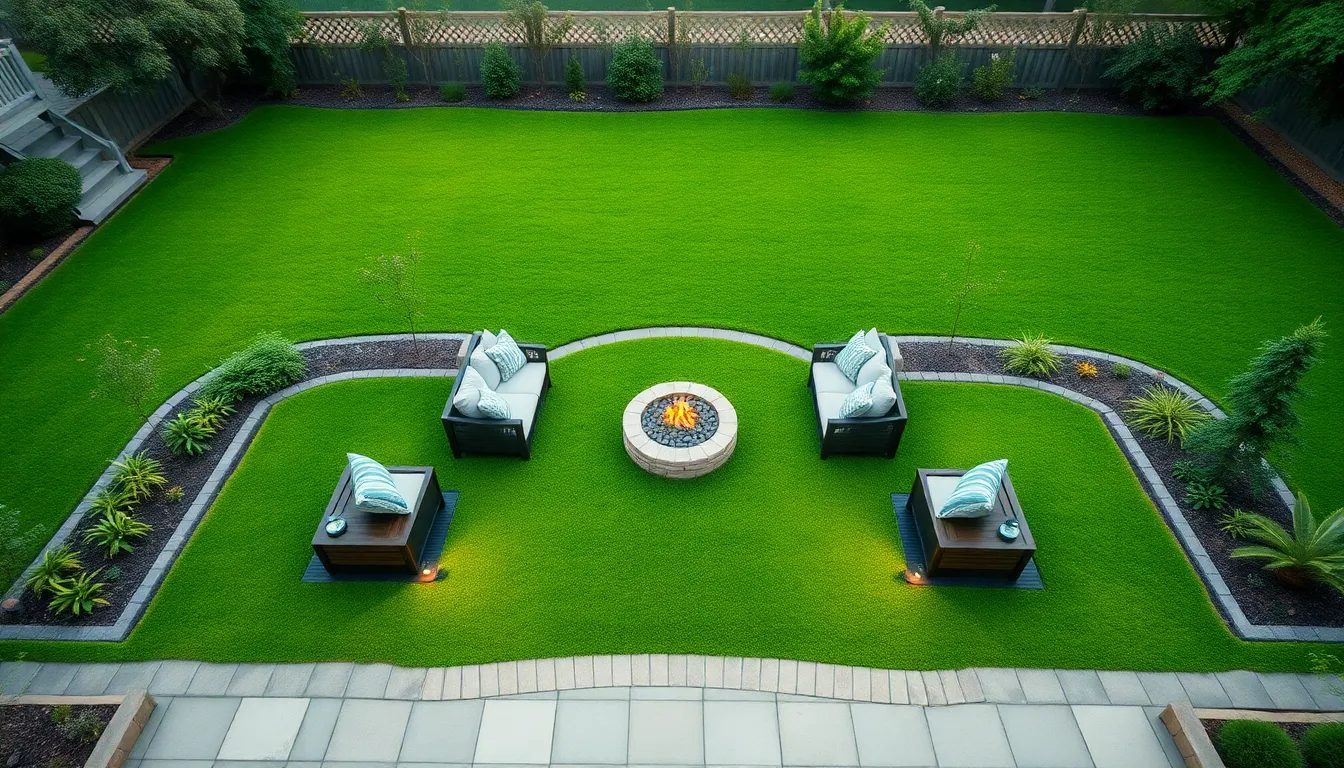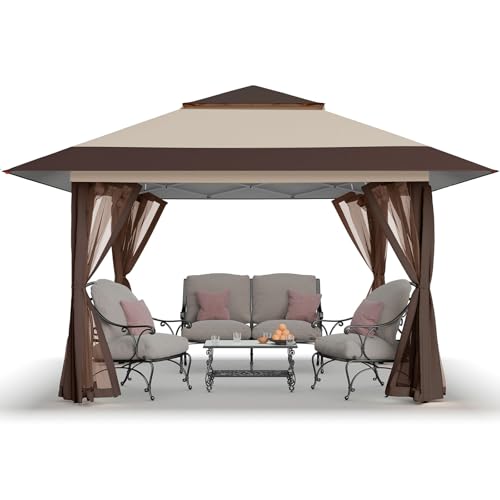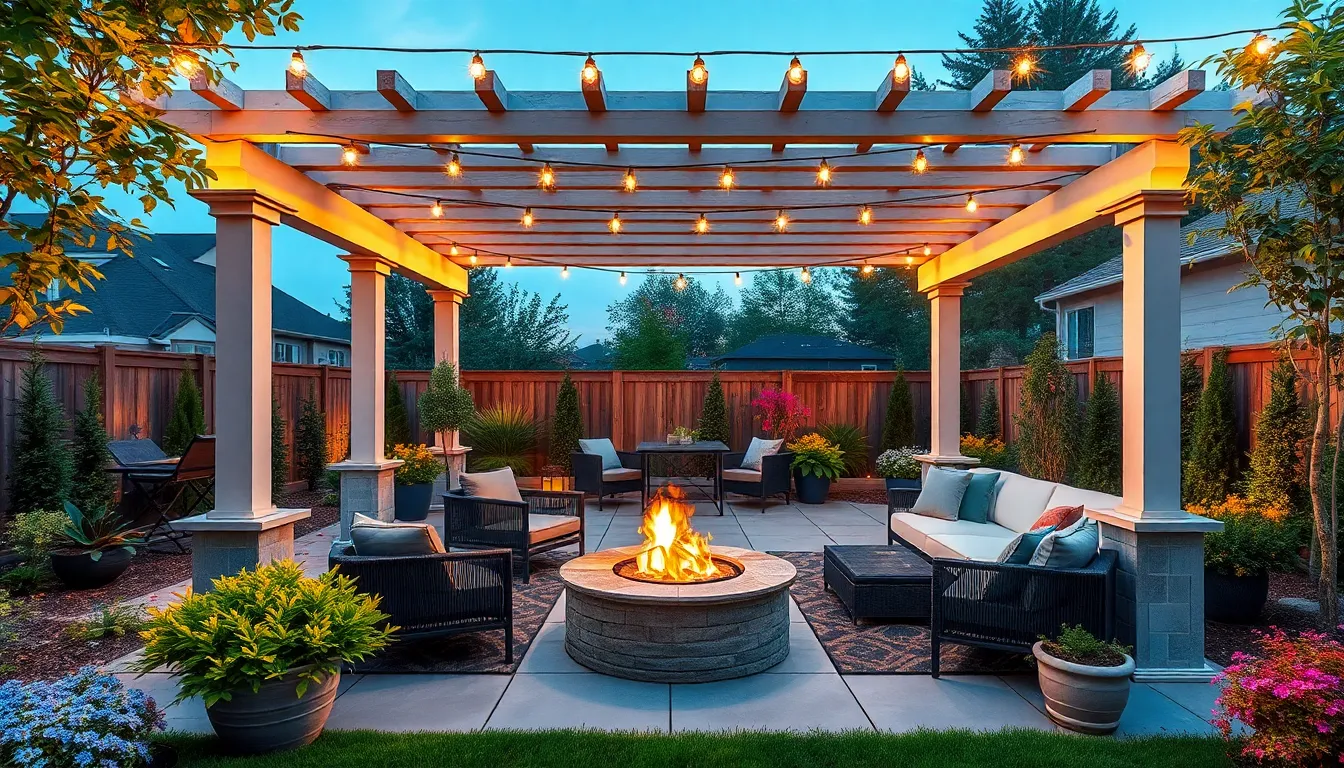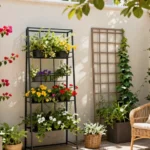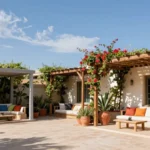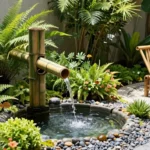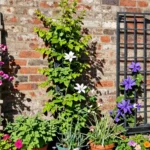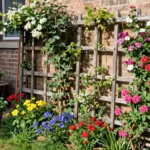We know how challenging it can be to design an L-shaped backyard. These uniquely angled outdoor spaces often leave homeowners scratching their heads about how to maximize every corner and create functional zones that flow together seamlessly.
The good news? L-shaped yards actually offer incredible design opportunities that traditional rectangular spaces simply can’t match. We’ve discovered that these distinctive layouts allow for natural room divisions and create perfect spots for multiple activity areas – from cozy dining nooks to expansive entertainment zones.
Whether you’re dealing with a small L-shaped patio or a sprawling backyard that wraps around your home we’ll show you how to transform those awkward angles into your yard’s greatest assets. Get ready to unlock the hidden potential of your unique outdoor space with clever design strategies that’ll make your neighbors wonder why they settled for boring square yards.
Create Distinct Zones for Maximum Functionality
Successful L-shaped backyard design requires strategic zone planning that maximizes each section’s potential. We’ll transform your unique outdoor space into multiple functional areas that serve different purposes while maintaining visual harmony.
Entertainment Area Design
Entertainment zones work best in the wider section of your L-shaped yard where guests can gather comfortably. Position your main seating area along the longest wall to create a natural conversation space that feels intimate yet spacious. Built-in benches with weather-resistant cushions provide permanent seating answers that don’t overwhelm the space.
Fire pits serve as excellent focal points for entertainment areas, creating warmth and ambiance during evening gatherings. We recommend placing them at least 8 feet from any structures and surrounding them with comfortable seating in a circular arrangement. Outdoor kitchens or grilling stations integrate seamlessly into entertainment zones, especially when positioned near the house for easy access to indoor amenities.
String lights and industry lighting extend the usability of entertainment areas into nighttime hours. Install dimmers to adjust lighting levels based on the occasion, from bright task lighting for cooking to soft ambient lighting for intimate conversations.
Quiet Retreat Space
Retreat spaces thrive in the narrower section of L-shaped yards where privacy feels naturally enhanced. Create a secluded reading nook with a comfortable chair or small bench positioned to take advantage of morning or afternoon shade. Privacy screens made from bamboo, lattice panels, or tall plantings help separate this zone from more active areas.
Water features add tranquil sounds that mask neighborhood noise and create a spa-like atmosphere. Small fountains, birdbaths, or even a simple water bowl can provide the soothing sounds of moving water without requiring extensive plumbing. Position these features where they’re visible from your retreat seating for maximum relaxation benefits.
Fragrant plants enhance the sensory experience of quiet spaces. Lavender, jasmine, and herbs like rosemary release pleasant scents that promote relaxation and create a multi-sensory retreat environment.
Activity-Exact Sections
Activity zones require careful planning to ensure each space serves its intended purpose without interfering with adjacent areas. Designate exact areas for children’s play equipment, keeping them visible from entertainment zones while maintaining enough distance to prevent disruption. Soft ground coverings like rubber mulch or artificial turf create safe play surfaces.
Gardening sections work well in areas that receive appropriate sunlight for your chosen plants. Raised beds or container gardens keep growing areas organized and make maintenance easier. Position tool storage nearby to create efficient workflows for garden maintenance.
Exercise areas benefit from level surfaces and adequate clearance for movement. Yoga platforms, putting greens, or simple workout spaces require minimal equipment but need proper placement to avoid conflicts with other activities. Consider sight lines and noise levels when positioning these zones to maintain harmony throughout your L-shaped layout.
Maximize Your Corner Space with Strategic Focal Points
Corner spaces in L-shaped backyards often present the greatest design challenges, yet they offer the most potential for creating stunning focal points. We’ll show you how to transform these awkward angles into showpiece features that anchor your entire outdoor layout.
Corner Garden Features
Transform your inner corner into a lush garden sanctuary where the two wings of your L meet naturally. This enclosed space provides the perfect opportunity to create raised garden beds that capitalize on the natural privacy the corner formation offers. Vertical gardening elements like trellises or living walls can soften the harsh angles while maximizing your planting space in this compact area.
Design curved landscaping elements to counteract the rigid lines of your L-shaped yard. Flowing garden borders and rounded plantings create visual interest while making the corner feel more organic and inviting. Strategic placement of ornamental grasses, flowering shrubs, and climbing vines can turn this once difficult space into your backyard’s most captivating feature.
Create different planting heights using container gardens, raised beds, and ground level plantings to add depth and dimension. This layered approach draws the eye through the corner space and makes it feel larger than its actual footprint.
Fire Pit or Outdoor Fireplace Placement
Position your fire pit at the intersection of the L-shape to create an instant gathering spot that maximizes corner functionality. This placement naturally draws people into the space and provides a central focal point that unifies both sections of your backyard. Comfortable seating arranged in a semicircle around the fire feature encourages conversation and makes the area perfect for evening entertainment.
Install cooking grates or spark screens to enhance the functionality of your corner fire pit area. These accessories transform your fire feature from a simple heating element into a complete outdoor cooking and entertainment station. Built-in seating walls or moveable furniture can accommodate different group sizes while maintaining the intimate feel of the corner space.
Consider an outdoor fireplace for a more permanent and dramatic focal point in your corner area. Stone or brick construction can complement your home’s architecture while providing year-round functionality and visual impact.
Water Feature Integration
Install a fountain or small pond at the corner junction to create a tranquil retreat that masks neighborhood noise. The sound of flowing water provides a peaceful atmosphere while serving as an elegant focal point that visually connects both arms of your L-shaped layout. Custom-built stone waterfalls can integrate seamlessly with existing landscaping while adding height and movement to the corner space.
Choose modern water walls for a sleek, contemporary look that complements modern home designs. These vertical features take up minimal ground space while providing maximum visual impact and the soothing sounds of cascading water. Linear water features can follow the angles of your L-shaped yard, creating a cohesive design element that ties the entire space together.
Combine water features with lighting to extend the enjoyment of your corner space into evening hours. Underwater LED lights or subtle industry lighting around the water feature creates a magical ambiance that transforms your corner into a nighttime destination.
Design Smooth Traffic Flow Between Areas
Creating seamless movement throughout your L-shaped backyard requires thoughtful planning that connects each zone while maintaining functionality. We’ll explore essential strategies for establishing natural flow patterns that make your outdoor space feel cohesive and inviting.
Natural Pathways and Walkways
Stone pathways provide the foundation for smooth traffic flow between your distinct backyard zones. We recommend using stone-look or natural stone paving materials for both durability and visual appeal that complements various industry styles. These pathways serve as subtle boundaries without creating isolation between areas, maintaining an open feel throughout your space.
Curved walkways soften the angular nature of L-shaped yards and create more organic movement patterns. Rather than following straight lines that emphasize the rigid angles, gently winding paths make the flow feel natural and less structured. This approach transforms potential awkwardness into graceful transitions that guide visitors intuitively from one zone to another.
Strategic pathway placement eliminates congestion and prevents awkward transitions between functional areas. We position walkways to connect high-traffic zones like dining patios to lounging decks, ensuring clear sight lines and comfortable width for multiple people. The key is creating routes that feel purposeful rather than forced, allowing natural movement that enhances the backyard’s usability.
Strategic Placement of Transitions
Low hedges create effective zone definitions without blocking visual connections or physical movement. We use these living boundaries to subtly separate dining areas from play spaces or gardening zones while maintaining sight lines across the entire yard. Different ground materials and surface textures also serve as transition markers that define spaces without creating barriers.
The inner corner where your L-shaped yard’s two wings meet offers prime real estate for intimate gathering spaces. This often underutilized area provides maximum privacy and enclosure while naturally connecting both arms of your backyard layout. We transform these corners into cozy patios or intimate seating areas that serve as transition hubs between different functional zones.
Pergolas and overhead structures mark functional area changes while providing practical benefits. These architectural elements create visual and physical transitions that clearly define spaces like dining nooks or lounge areas. Multi-level designs using terraces or retaining walls enhance this effect, especially on sloped properties where natural stepping points create visual interest and improved flow.
Visual Connection Points
Focal points unify different zones while drawing the eye through your L-shaped industry design. We anchor layouts with strategically placed water features, fire pits, sculptures, or beautifully landscaped garden beds that create visual continuity across separate areas. These elements serve as destination points that encourage exploration and movement throughout the space.
Vertical gardening maximizes greenery without sacrificing floor space in compact L-shaped yards. Trellises, living walls, and varied plant heights along one side create cozy atmospheres while connecting zones visually. This approach adds depth and dimension that makes the backyard feel larger and more cohesive than traditional flat landscaping methods.
Varying heights in plants, walls, and seating areas enhance visual depth throughout your outdoor space. We layer different elevations to create ever-changing sight lines that guide movement and maintain interest from every vantage point. This three-dimensional approach transforms the challenges of L-shaped layouts into opportunities for sophisticated outdoor living environments that feel both functional and aesthetically pleasing.
Utilize Vertical Elements to Define Spaces
Vertical elements transform L-shaped backyards from awkward spaces into well-organized outdoor environments. These strategic features help us demarcate distinct zones while maintaining visual flow throughout our uniquely angled yards.
Privacy Screens and Dividers
Privacy screens create essential seclusion within L-shaped backyards while defining separate activity areas. We can install fence panels, bamboo screens, or tall hedges to enclose patios and separate play areas from adult entertaining zones. These dividers reduce exposure to neighbors and street noise, making our outdoor spaces more intimate and functional.
Decorative screens serve dual purposes by improving privacy while adding aesthetic appeal to our industry design. We’ll want to choose materials that complement our overall design theme, whether it’s modern metal panels or natural wood dividers. Strategic placement of these elements helps us create a backdrop for outdoor entertaining while maintaining clear sight lines where desired.
Tall hedges work particularly well as living privacy barriers that soften the angular nature of L-shaped yards. We can plant evergreen varieties for year-round coverage or deciduous options that change with the seasons. These natural screens filter wind and noise while providing habitat for beneficial wildlife.
Vertical Gardens and Green Walls
Vertical gardens maximize our planting opportunities without consuming valuable ground space in compact L-shaped yards. We can install modular planters and trellises that support climbing plants, transforming blank walls and fences into lush living art pieces. These green walls improve air quality while adding dramatic visual impact to our outdoor spaces.
Wall-mounted planters create instant garden displays that work especially well in the narrower sections of L-shaped yards. We’ll find that these systems allow us to grow herbs, flowers, and even vegetables at eye level, making maintenance easier and more enjoyable. Drip irrigation systems can be integrated to ensure consistent watering without daily maintenance.
Climbing plants on trellises help us integrate greenery into patios and seating areas naturally. We can choose fast-growing vines like clematis or jasmine that provide quick coverage and seasonal interest. These vertical elements guide the eye upward, making our L-shaped spaces feel larger and more ever-changing than traditional horizontal layouts.
Multi-Level Landscaping
Multi-level designs create visual interest and enhance spatial definition throughout L-shaped backyards. We can incorporate raised decks, step-down patios, and terraced plant beds that establish a sense of progression as people move through different zones. This layered approach makes awkwardly shaped yards feel intentionally designed and sophisticated.
Retaining walls provide additional planting surfaces while managing slopes and grade changes common in L-shaped lots. We’ll discover that these structures create natural seating areas and help define boundaries between different functional zones. Stone or block walls add permanent structure that anchors our industry design year-round.
Terraced gardens work particularly well in the corner areas where the L-shape creates natural elevation changes. We can build stepped planters that follow the contours of our yard, creating depth and visual flow. These multi-level features increase our total planting area while making the space feel larger and more ever-changing than single-level designs.
Optimize Planting for L-Shaped Dimensions
Strategic plant placement transforms the unique angles of L-shaped yards into cohesive, visually stunning landscapes. We’ll show you how to leverage your yard’s distinctive shape for maximum planting impact.
Border Plantings Along Edges
Border plantings along the perimeter create natural boundaries that enhance your L-shaped yard’s visual appeal. We recommend using flowering shrubs like hydrangeas or azaleas to soften the hard angles where your property lines meet. These plantings work particularly well along fence lines, creating a living wall that provides privacy while adding seasonal interest.
Dense plantings of mixed perennials create textural variety along longer edges of your L-shaped space. Consider combining ornamental grasses like fountain grass with colorful annuals such as marigolds and petunias for continuous blooms throughout the growing season. Low-growing groundcovers like creeping phlox or ajuga fill gaps between larger plants, creating a polished, professional appearance.
Evergreen border plantings provide year-round structure and screening. We suggest incorporating boxwood hedges or compact conifers to maintain definition during winter months when deciduous plants lose their leaves.
Foundation Plantings for Structure
Foundation plantings anchor your home to the industry while providing essential structure to your L-shaped design. We position evergreen shrubs like juniper or yew around the house foundation to create a strong visual connection between your home and yard. These plantings serve as permanent fixtures that frame your outdoor spaces throughout all seasons.
Layered foundation plantings create depth and visual interest against your home’s exterior walls. Start with taller shrubs closest to the house, then graduate to medium-height plants like spiraea or weigela, finishing with low-growing options such as hostas or coral bells. This tiered approach ensures each plant receives adequate sunlight while creating a sophisticated, landscaped appearance.
Strategic placement of small ornamental trees near foundation corners adds vertical interest to your L-shaped layout. Japanese maples, flowering crabapples, or dwarf fruit trees provide seasonal color while maintaining appropriate scale for residential landscapes.
Seasonal Color Arrangements
Seasonal color arrangements ensure your L-shaped backyard maintains visual appeal throughout the entire year. We design spring displays using early-blooming bulbs like crocuses and daffodils, which naturalize over time and provide the first bursts of color after winter. Plant these bulbs in clusters throughout your garden beds for maximum impact when they emerge.
Summer perennials form the backbone of our seasonal color strategy. Daylilies, black-eyed Susans, and coneflowers provide months of continuous blooms while requiring minimal maintenance once established. These hardy plants thrive in various light conditions, making them perfect for the different exposures found in L-shaped yards.
Autumn foliage plants extend your garden’s appeal well into fall months. We incorporate burning bush, Japanese maple, and ornamental grasses that develop striking red, orange, and gold colors as temperatures cool. Winter berry-producing plants like winterberry holly or beautyberry provide food for wildlife while adding color to the dormant industry.
Plan succession plantings to ensure continuous blooms from spring through fall. Stagger planting times for annuals like zinnias and cosmos to maintain fresh flowers throughout the growing season, replacing spent blooms with new plantings every 4-6 weeks.
Incorporate Functional Hardscaping Elements
Strategic hardscaping transforms L-shaped backyards into cohesive outdoor living spaces that maximize both function and visual appeal. We’ll explore three essential hardscaping approaches that work exceptionally well with the unique angles and dimensions of L-shaped yards.
Patio and Deck Configurations
L-shaped patios mirror your yard’s natural angles and create seamless transitions between different activity zones. Aligning your patio configuration with the yard’s shape enhances flow while supporting multiple use areas like dining on one arm and lounging on the other.
Material choices define each space distinctly:
- Natural stone patios provide durability for dining areas
- Weather-resistant wood decks offer warmth for relaxation zones
- Composite materials deliver low maintenance for high-traffic areas
- Brick pavers create classic appeal with flexible design options
Consider installing complementary deck shapes that follow the L-pattern for comfortable movement between zones. This approach maximizes usable space while maintaining visual harmony throughout your outdoor environment.
Retaining Walls and Borders
Retaining walls serve dual purposes in L-shaped backyards by managing elevation changes and creating defined spaces for different activities. These structures prevent soil erosion while establishing level planting areas that work with your yard’s natural contours.
Stone and masonry walls offer multiple benefits:
- Visual borders that frame garden beds and pathways
- Structural support for sloped areas
- Added texture and architectural interest
- Delineated zones within the overall layout
Decorative borders complement retaining walls by softening hard edges and connecting different hardscape elements. We recommend using consistent materials throughout to maintain design cohesion while addressing practical slope management needs.
Built-In Seating Answers
Built-in seating maximizes your L-shaped yard’s potential while reducing the need for movable furniture that can clutter the space. Strategic placement around patios or along retaining walls creates functional gathering spots that work with your yard’s unique angles.
L-shaped bench configurations provide optimal answers:
- Stone benches that match hardscape materials
- Wooden seating that complements deck structures
- Multi-level seating for varied group sizes
- Integrated storage beneath seating surfaces
Positioning built-in seating to mirror your yard’s shape creates a cohesive, streamlined design that offers ample space for entertaining or relaxing. This approach contributes to a unified aesthetic while providing practical functionality that works year-round.
Balance Open Areas with Intimate Nooks
Creating the perfect balance between spacious and cozy areas transforms your L-shaped backyard into a multifunctional outdoor haven. We’ll show you how to design distinct zones that complement each other while maximizing your unique yard shape.
Open Lawn Spaces
Designate one section of your L-shaped yard as an expansive lawn area that serves as the breathing room your outdoor space needs. This open green expanse provides a versatile foundation for various activities while creating visual contrast against more structured zones throughout your backyard.
Position the lawn in the wider portion of your L-shape to maximize its impact and functionality. We recommend maintaining at least 300-400 square feet of uninterrupted grass space for optimal versatility in activities like games, gatherings, or simply enjoying the view.
Border your lawn with raised garden beds that follow the natural contours of your L-shaped perimeter. These elevated plantings add lush greenery and seasonal color while defining the space without creating harsh boundaries that interrupt the flow.
Use the lawn as a transition zone between different activity areas, allowing it to serve as a natural pathway that connects your cozy nooks with entertainment spaces. This approach maintains openness while providing clear sight lines across your entire backyard.
Cozy Conversation Areas
Transform the inner corner of your L-shape into an intimate conversation area that takes advantage of the natural enclosure formed by your yard’s wings. This protected space creates a sense of privacy and intimacy that’s perfect for evening chats or small gatherings.
Install comfortable seating arranged in a circular or U-shaped pattern to encourage face-to-face interaction and create a welcoming atmosphere. We suggest using weather-resistant furniture with plush cushions and outdoor curtains for added comfort and visual appeal.
Define this zone with durable materials like natural stone pavers or composite decking that can withstand heavy foot traffic while adding aesthetic value. Consider adding a pergola or gazebo overhead to provide shade during the day and support for string lights or lanterns.
Include a central focal point such as a fire pit or low coffee table to anchor the space and provide functionality. The fire feature extends the usability of your conversation area into cooler months while creating a warm, inviting ambiance.
Reading and Relaxation Spots
Carve out a tranquil corner specifically designed for quiet activities like reading, meditation, or solo relaxation. This dedicated space should feel separate from more active areas while remaining accessible and inviting.
Install a comfortable single chair, hammock, or built-in bench that provides ergonomic support for extended periods of relaxation. We recommend positioning this furniture to take advantage of natural shade or creating shade with a small pergola or umbrella.
Surround your reading nook with privacy elements like vertical gardens, decorative screens, or tall plantings that create a sense of enclosure. These features help filter noise from other areas while adding visual interest and natural beauty.
Incorporate soft lighting options such as solar lanterns, LED strip lights, or a small table lamp designed for outdoor use. This lighting extends the usability of your relaxation spot into evening hours while creating a serene atmosphere perfect for unwinding.
Plan for Year-Round Usability
We can transform our L-shaped backyard into a space that’s functional and inviting throughout every season. Strategic planning ensures our outdoor investment provides maximum enjoyment regardless of weather conditions.
Seasonal Design Considerations
Weather protection structures become essential elements in our year-round design strategy. Installing a modern pergola at the intersection of our L-shape’s two wings offers shade during summer months while providing framework for retractable canopies or curtains when cooler weather arrives.
Plant selection drives our seasonal success by incorporating vertical gardening and raised beds with varieties that thrive in different seasons. We’ll maintain visual interest year-round by choosing plants that offer spring blooms, summer foliage, autumn colors, and winter structure.
Functional zoning maximizes our space’s versatility by creating distinct areas for dining, lounging, and gardening activities. Each zone serves different purposes throughout the seasons, ensuring our backyard remains useful whether we’re hosting summer barbecues or enjoying quiet winter mornings.
Weather-Resistant Features
Durable materials form the foundation of our weather-resistant design approach. Natural stone paving and stone-look surfaces withstand harsh conditions in high-traffic areas while maintaining their appearance through multiple seasons.
All-weather furniture eliminates the hassle of constant maintenance and storage. We’ll invest in pieces made from weather-resistant materials that can remain outdoors year-round without damage or deterioration.
Fire and water elements create seasonal balance in our outdoor space. A fire pit provides warmth and gathering opportunities during colder months, while water features offer cooling relief and relaxation during warmer seasons.
Lighting for Evening Use
Ambient lighting systems extend our backyard’s usability well into the evening hours. String lights and hanging fixtures around pergolas and seating areas create cozy atmospheres perfect for nighttime entertaining and relaxation.
Focused illumination enhances both safety and aesthetics through strategic placement of pathway lights and spotlights. We’ll highlight walking routes, focal points like fire pits or water features, and sculptural elements to ensure our space remains functional and visually appealing after dark.
Layered lighting approaches combine multiple fixture types to create depth and visual interest. By mixing ambient, task, and accent lighting, we’ll achieve professional-quality illumination that transforms our L-shaped backyard into an enchanting evening destination.
Address Common L-Shaped Challenges
While L-shaped backyards offer unique design opportunities, they also present exact obstacles that we need to address strategically. Let’s explore practical answers to overcome these common challenges and maximize your outdoor space potential.
Awkward Corner Answers
Corner spaces often create the most frustrating design puzzles in L-shaped yards. We recommend transforming your inner corner into a cozy, private patio or intimate seating nook that naturally provides enclosure and privacy. This strategic approach helps unify the two wings of your yard while creating an ideal spot for quiet relaxation or intimate gatherings.
Built-in benches with storage underneath maximize functionality while maintaining clean lines. Adding a small side table or built-in planters creates visual interest without overwhelming the space. We’ve found that incorporating vertical elements like trellises or tall planters helps draw the eye upward and makes the corner feel more intentional rather than leftover space.
Consider installing a corner pergola or shade structure to define the area further. This addition creates a distinct outdoor room that feels purposeful and inviting rather than awkward or forgotten.
Sight Line Management
Breaking your backyard into distinct functional zones helps create harmonious flow and enticing sight lines throughout the space. We suggest designing separate areas for dining, lounging, and gardening using different materials like pavers, wooden decks, or mulch to naturally delineate each zone.
Subtle dividers such as low hedges and curved pathways guide movement without creating barriers. This layered approach adds depth and visual interest while preventing the yard from feeling like two disconnected spaces. Strategic placement of focal points like sculptures or water features draws attention and creates natural viewing corridors.
Varying plant heights and textures along sight lines adds dimension and prevents monotonous views. We recommend placing taller elements at the back of garden beds and shorter ones in front to create depth and visual flow between different areas of your yard.
Maintenance Accessibility
Planning for easy maintenance access prevents future headaches and keeps your yard looking pristine year round. We recommend creating clear pathways throughout your design that allow you to reach all areas comfortably with tools and equipment.
Raised beds and vertical gardens save space while reducing ground level maintenance requirements. These elevated answers make weeding, watering, and harvesting much easier on your back and knees. Strategic placement of garden beds near water sources and storage areas minimizes the distance you need to carry supplies.
Multi-level designs with retaining walls and terraces help organize planting areas and make them more accessible. Selecting durable paving materials for high traffic zones reduces ongoing maintenance while providing stable surfaces for wheelbarrows and garden carts. We suggest installing drip irrigation systems in harder to reach areas to minimize manual watering requirements.
Conclusion
We’ve shown you how L-shaped backyards can become your home’s greatest outdoor asset with the right approach. These unique spaces offer endless possibilities for creating distinct zones that serve different purposes while maintaining visual harmony throughout your industry.
The key lies in embracing rather than fighting your yard’s natural angles. By thoughtfully planning each section and implementing smart design answers like proper lighting and strategic plant placement you’ll create an outdoor environment that’s both beautiful and highly functional.
Remember that success comes from treating each section of your L-shaped yard as an opportunity rather than a limitation. With careful zone planning corner optimization and maintenance considerations your backyard will become the envy of neighbors with traditional rectangular spaces.
Frequently Asked Questions
What makes L-shaped backyards challenging to design?
L-shaped backyards present unique challenges due to their irregular angles and awkward corner spaces. Unlike traditional rectangular yards, these spaces can be difficult to visualize and plan effectively. The unusual layout often creates dead zones or areas that feel disconnected, making it harder for homeowners to maximize functionality and create cohesive outdoor living spaces.
How can I create distinct zones in my L-shaped backyard?
Focus on using the natural divisions of your L-shaped layout to your advantage. Designate the wider section for entertainment areas with seating and fire pits, while utilizing the narrower section for quiet retreat spaces. Use different materials, lighting, and landscaping elements to clearly define each zone while maintaining visual flow throughout the space.
What should I do with the corner spaces in my L-shaped yard?
Transform corner spaces into focal points rather than leaving them as dead zones. Inner corners work perfectly for cozy patios or intimate seating nooks with built-in benches and storage. Add vertical elements like trellises or screens to create privacy and visual interest. These corners can become the most charming features of your outdoor space.
How do I manage sight lines in an L-shaped backyard?
Create distinct functional zones for dining, lounging, and gardening while ensuring smooth visual transitions between areas. Use strategic placement of plants, hardscaping materials, and outdoor furniture to guide the eye naturally through the space. Avoid blocking important views while maintaining clear pathways between different zones.
What’s the best way to maintain an L-shaped backyard?
Design clear pathways throughout your L-shaped yard to ensure easy access for maintenance. Consider elevated garden beds and multi-level designs with retaining walls to organize planting areas efficiently. Install drip irrigation systems for easier watering, and choose low-maintenance plants that suit each zone’s specific conditions and sun exposure.
Can L-shaped backyards accommodate children’s play areas?
Absolutely! L-shaped yards are excellent for creating dedicated children’s play zones without interfering with adult entertainment areas. Use the natural divisions to separate active play spaces from quiet areas. Ensure clear sight lines from indoor spaces for supervision, and choose soft landscaping materials around play equipment for safety.

